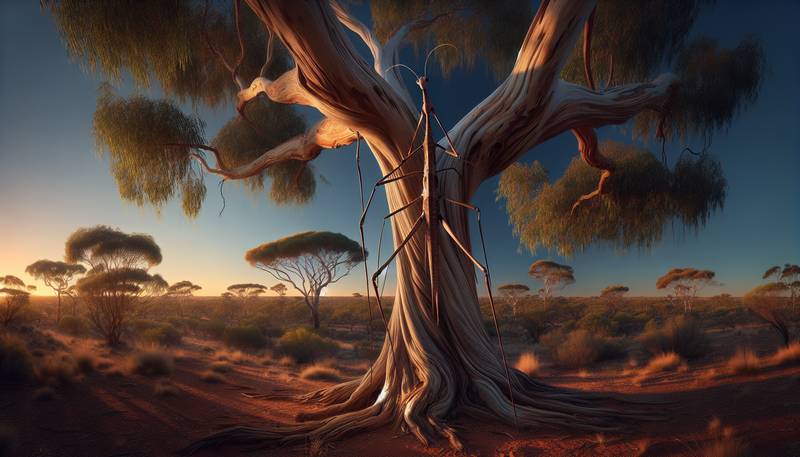Australian Stick Insect: Master of Camouflage in Australia

The Enigmatic Eucalyptus EnthusiastPerched atop a eucalyptus tree, our protagonist awaits its next meal, hiding in plain sight from unsuspecting passersby. The Australian stick insect (Ctenomorpha chronus), a master of disguise and one of the world's most adept practitioners of camouflage, possesses a long, slender body that mimics the branches of the trees it inhabits. Though not exclusively a eucalyptus enthusiast, its affinity for the Australian icon has earned it the nickname "Eucalyptus Stick Insect."But there's more to this enigmatic creature than its arboreal antics. To truly appreciate this peculiar invertebrate, we must delve into its history, cultural significance, and the unique attractions it calls home. So, strap in, grab your magnifying glass, and join me as we investigate the Australian stick insect's life as a master of disguise.Walking Stick or Walking Myth?The Australian stick insect boasts a storied history that dates back to the Dreamtime, a period in Aboriginal mythology when ancestral spirits shaped the land and its creatures. According to one legend, the stick insect was once a man who encountered an evil sorcerer. The sorcerer used his dark magic to turn the man into a stick, rendering him incapable of movement. Over time, the man learned to accept his new form and developed the ability to move about, eventually becoming the stick insect we know today.While the Dreamtime story paints a vivid picture of the stick insect's origins, the truth is a bit more scientific. The first recorded sighting of an Australian stick insect was in 1843 by an intrepid explorer named Charles Ludwig Gloger, who was astounded by the creature's incredible resemblance to its eucalyptus brethren and promptly named it "Phasma chronus".Australia's Most Elusive InhabitantsAlthough they're not as famous as kangaroos or koalas, stick insects have earned a special place in Australian culture. These masters of disguise can be found throughout the continent, from the tropical rainforests of Queensland to the temperate woodlands of Tasmania. There are over 150 known species of stick insects in Australia, each with its own unique brand of camouflage. The most common species, Ctenomorpha chronus, is usually green or brown and can reach lengths of 20 centimeters (nearly 8 inches).The Australian stick insect has also inspired the country's art. Aboriginal artists have incorporated the creature's distinctive form into their work, often painting intricate patterns that mimic the insect's striated exoskeleton. The stick insect has even made its way into urban street art, with a particularly striking example found in Melbourne's famous Hosier Lane.Discovering the Masters of DisguiseFinding an Australian stick insect in the wild can be a bit like searching for a needle in a haystack, or more accurately, a stick in a forest. However, there are a few places where you can increase your odds of spotting these elusive creatures.- Mount Hypipamee National Park, Queensland: This lush rainforest park is home to a variety of stick insect species, including the green "Children's Stick" (Tropidoderus childrenii) and the impressive "Giant Prickly Stick" (Extatosoma tiaratum). Keep an eye out for these masters of disguise on trees and plants along the walking trails.
- Tarkine Wilderness, Tasmania: The Tarkine Wilderness is a haven for stick insects, many of which are found nowhere else in the world. Trek through the ancient rainforests and you might just catch a glimpse of the aptly named "Tarkine Stick Insect" (Candovia tarkina).
- Australian National Insect Collection, Canberra: If you'd prefer your stick insects to be a little less camouflaged, head to the Australian National Insect Collection in Canberra. Here, you'll find an impressive array of stick insects, including live specimens that you can observe up close.
Unmasking the Masters of DisguiseSo, there you have it: a deep dive into the world of the Australian stick insect, a creature that has captivated the imaginations of artists, scientists, and the odd adventure-seeking writer. From its mythical origins to its modern-day status as a symbol of adaptation and survival, the stick insect is a testament to the wonders of natural selection and the power of camouflage.As you venture forth into the wilds of Australia, keep your eyes peeled for these masters of disguise. And if you're lucky enough to spot one, remember to pay your respects to the ancient spirit that once found itself transformed into a living, breathing branch.
|
|







